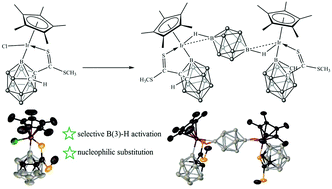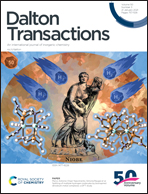Regioselective B(3)–H bond activation based on an o-carboranyl dithiocarboxylate ligand and its derivatives†
Abstract
Herein, we describe the synthesis of tetraphenylphosphonium o-carboranyl dithiocarboxylate (Ligand 1) and methyldithiocarboxyl-o-carborane (Ligand 2). The complexes [Cp*M(o-C2B10H11CS2)Cl] (M = Ir (3); Rh (4)) and [Cp*M(o-C2B10H11CS2)2] (M = Ir (5); Rh (6)) have been synthesized based on Ligand 1. The selective B–H bond activation of Ligand 2 has also been explored, leading to the synthesis of the B–H activated complex [Cp*Ir(o-C2B10H10CS2CH3)Cl] (7) and four of its substituted derivatives (8, 9, 10 and 11). All of these compounds have been characterised through single-crystal X-ray diffraction, NMR, IR spectroscopy and elemental analysis.

- This article is part of the themed collection: Celebrating our Golden Authors


 Please wait while we load your content...
Please wait while we load your content...